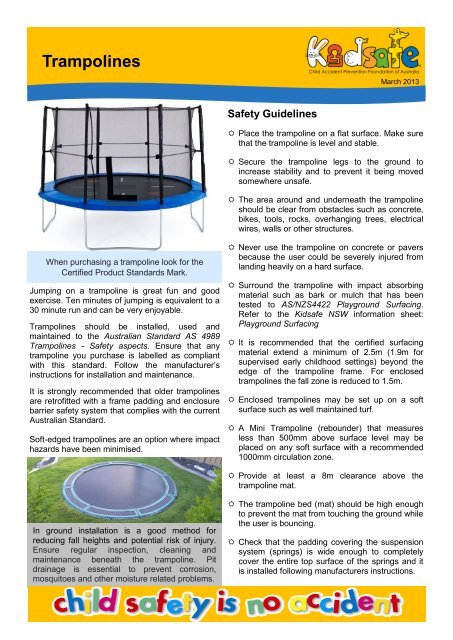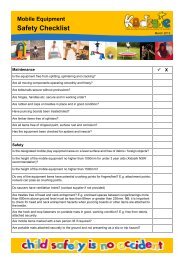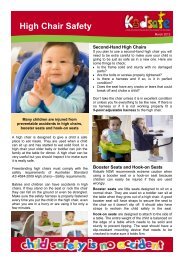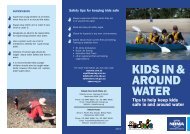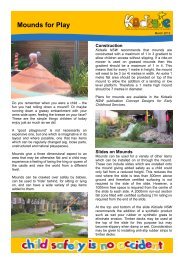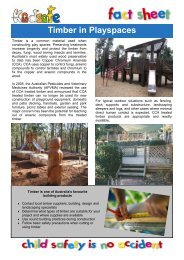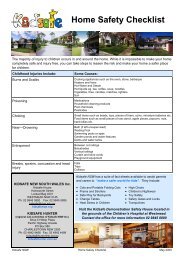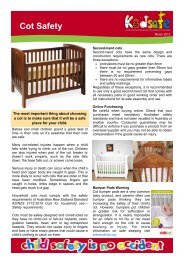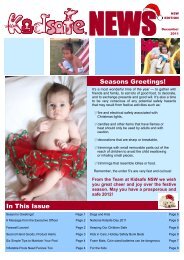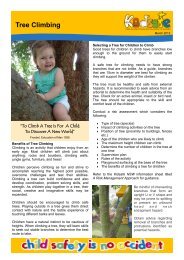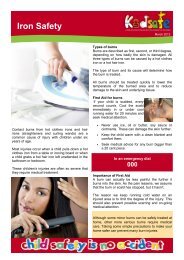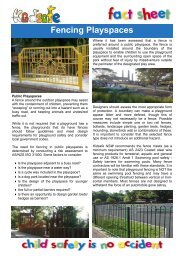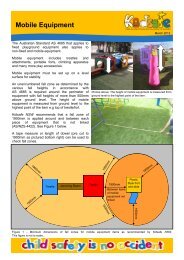Trampolines - Kidsafe NSW
Trampolines - Kidsafe NSW
Trampolines - Kidsafe NSW
You also want an ePaper? Increase the reach of your titles
YUMPU automatically turns print PDFs into web optimized ePapers that Google loves.
<strong>Trampolines</strong><br />
Child Accident Prevention Foundation of Australia<br />
March 2013<br />
Safety Guidelines<br />
Place the trampoline on a flat surface. Make sure<br />
that the trampoline is level and stable.<br />
Secure the trampoline legs to the ground to<br />
increase stability and to prevent it being moved<br />
somewhere unsafe.<br />
The area around and underneath the trampoline<br />
should be clear from obstacles such as concrete,<br />
bikes, tools, rocks, overhanging trees, electrical<br />
wires, walls or other structures.<br />
When purchasing a trampoline look for the<br />
Certified Product Standards Mark.<br />
Jumping on a trampoline is great fun and good<br />
exercise. Ten minutes of jumping is equivalent to a<br />
30 minute run and can be very enjoyable.<br />
<strong>Trampolines</strong> should be installed, used and<br />
maintained to the Australian Standard AS 4989<br />
<strong>Trampolines</strong> - Safety aspects. Ensure that any<br />
trampoline you purchase is labelled as compliant<br />
with this standard. Follow the manufacturer’s<br />
instructions for installation and maintenance.<br />
It is strongly recommended that older trampolines<br />
are retrofitted with a frame padding and enclosure<br />
barrier safety system that complies with the current<br />
Australian Standard.<br />
Soft-edged trampolines are an option where impact<br />
hazards have been minimised.<br />
Never use the trampoline on concrete or pavers<br />
because the user could be severely injured from<br />
landing heavily on a hard surface.<br />
Surround the trampoline with impact absorbing<br />
material such as bark or mulch that has been<br />
tested to AS/NZS4422 Playground Surfacing.<br />
Refer to the <strong>Kidsafe</strong> <strong>NSW</strong> information sheet:<br />
Playground Surfacing<br />
It is recommended that the certified surfacing<br />
material extend a minimum of 2.5m (1.9m for<br />
supervised early childhood settings) beyond the<br />
edge of the trampoline frame. For enclosed<br />
trampolines the fall zone is reduced to 1.5m.<br />
Enclosed trampolines may be set up on a soft<br />
surface such as well maintained turf.<br />
A Mini Trampoline (rebounder) that measures<br />
less than 500mm above surface level may be<br />
placed on any soft surface with a recommended<br />
1000mm circulation zone.<br />
Provide at least a 8m clearance above the<br />
trampoline mat.<br />
In ground installation is a good method for<br />
reducing fall heights and potential risk of injury.<br />
Ensure regular inspection, cleaning and<br />
maintenance beneath the trampoline. Pit<br />
drainage is essential to prevent corrosion,<br />
mosquitoes and other moisture related problems.<br />
The trampoline bed (mat) should be high enough<br />
to prevent the mat from touching the ground while<br />
the user is bouncing.<br />
Check that the padding covering the suspension<br />
system (springs) is wide enough to completely<br />
cover the entire top surface of the springs and it<br />
is installed following manufacturers instructions.
Maintenance<br />
Each day before use, check the condition of the<br />
trampoline mat and frame padding system for<br />
tears, detachments and weakening related to sun<br />
exposure.<br />
Check to ensure that the area under and around<br />
the trampoline is free of obstacles such as bicycles<br />
and other moveable play equipment.<br />
Inspect framework and springs for surface rust,<br />
corrosion or deterioration and check that they are<br />
attached properly.<br />
Regularly inspect and maintain surfacing<br />
materials to the correct depth as required.<br />
Maintaining a safe trampoline and using child<br />
safe practices can substantially reduce injury<br />
to children.<br />
Child Safe Practices<br />
Supervise children using the trampoline at all<br />
times.<br />
<strong>Trampolines</strong> are not recommended for children<br />
under six years of age.<br />
Show your child the correct use of the trampoline<br />
by teaching safe usage practices.<br />
Adults should model safe use of trampolines<br />
when children are present.<br />
Display clear safety signs such as “one at a<br />
time,” “bare feet only”, ”do not use when wet”,<br />
“do not jump onto or off the trampoline”.<br />
Keep toddlers away from the trampoline when in<br />
use to prevent them from going underneath the<br />
trampoline.<br />
Teach your child to jump in the centre of the mat.<br />
Teach your child to focus their eyes on the<br />
trampoline as this will help control bounce.<br />
Do not allow or attempt somersaults.<br />
Ensure the presence of a spotter to warn the<br />
trampoline user if they are moving off centre of<br />
the mat.<br />
Do not allow anyone to link the trampoline with<br />
chairs, ladders or planks.<br />
Toddler Trampoline with Safety Handle<br />
When using this type of<br />
trampoline ensure that the<br />
r e c o m m e n d e d s a f e t y<br />
guidelines are followed.<br />
Whilst the handle offers<br />
support for a young child<br />
learning to use a trampoline<br />
it is possible that a serious<br />
injury could occur if a child<br />
falls on the handle.<br />
Mini Trampoline (rebounder)<br />
Mini trampolines that measure less than 500mm<br />
above surface level may be placed on any soft<br />
surface with a recommended 1m circulation zone<br />
surrounding the trampoline.<br />
KIDSAFE NEW SOUTH WALES Inc.<br />
<strong>Kidsafe</strong> <strong>NSW</strong> Playground Advisory Unit<br />
P: 02 9845 0893 F: 02 9845 0895<br />
E: kidsafe@chw.edu.au<br />
kidsafensw.org<br />
Child Accident Prevention Foundation of Australia


